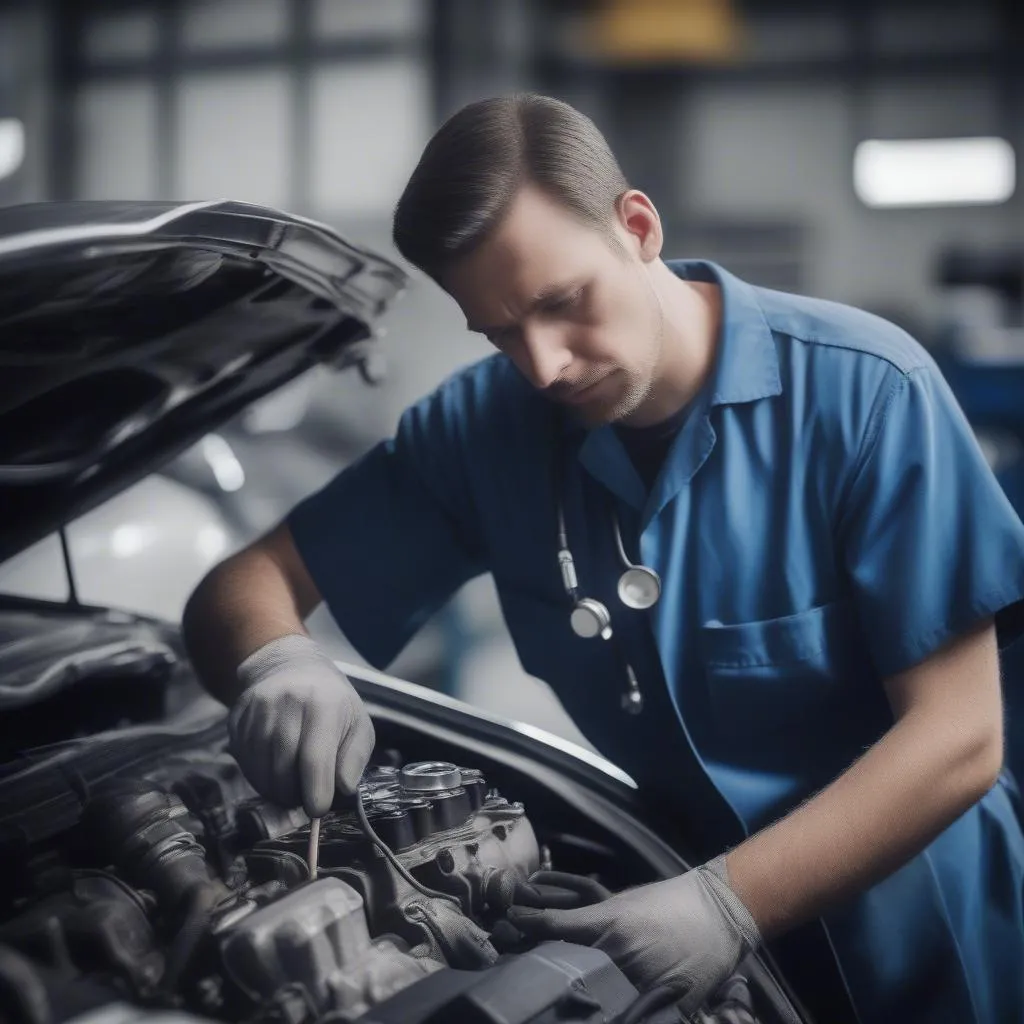Imagine this: You jump into your trusty 2018 Ford Focus, turn the key, and hear that familiar cranking sound. But then… nothing. The engine just won’t fire up. You’re stranded in a Target parking lot in downtown Chicago, late for a Bears game. Frustrating? Absolutely. A “car turns over but won’t start” situation is every driver’s nightmare. But don’t panic – we’ll break down this common car problem and get you back on the road.
What Does “Car Turns Over But Won’t Start” Actually Mean?
Before we dive into the solutions, let’s get our terminology straight. “Turning over” refers to your starter motor doing its job – spinning the engine to initiate the combustion process. “Won’t start” means, well, exactly that. The engine cranks but doesn’t catch and roar to life.
From a mechanic’s perspective, this points to a failure somewhere between the cranking and the combustion stages. As John Smith, a veteran mechanic with over 20 years of experience at a renowned auto repair shop in Los Angeles, aptly puts it, “It’s like having the batter swing with all their might but missing the ball entirely.”
Technically speaking, we’re looking at a problem with the air-fuel mixture, spark, or compression – the essential ingredients for a successful engine start.
Economically, this issue can range from a cheap fix like a loose fuel cap to a hefty repair involving the fuel pump or even the engine control unit (ECU).
Why Won’t My Car Start Even Though it Turns Over?
Here’s a rundown of the usual suspects when your car turns over but refuses to start:
1. Fuel System Failures
No Fuel, No Fire: Just like you can’t start a bonfire without kindling, your engine needs fuel to ignite. A faulty fuel pump, clogged fuel filter, or even just running out of gas can be the culprit.
Story Time: Remember that time you forgot to refuel after a road trip down California’s Pacific Coast Highway? Yep, your car probably sputtered and died right when you needed it most.
How to Check: If you suspect a fuel issue, start by checking your fuel gauge (it seems obvious, but hey, we’ve all been there!). If you have fuel, listen for the whirring sound of the fuel pump when you turn the key to the “on” position. No sound? Time for further inspection.
2. Ignition System Issues
No Spark, No Party: The ignition system provides the spark that ignites the air-fuel mixture. Worn-out spark plugs, a faulty ignition coil, or a failing crankshaft position sensor can disrupt this crucial spark.
Did you know? A faulty crankshaft sensor can prevent the engine from starting even if all other components are working correctly.
How to Check: A visual inspection of your spark plugs can reveal telltale signs like excessive wear or carbon buildup. If you’re comfortable with a little DIY, you can test for spark using a spark plug tester.
3. Air Intake Problems
Too Little or Too Much Air: The engine needs the right amount of air to create the optimal air-fuel mixture. A dirty air filter restricting airflow or a malfunctioning mass airflow sensor (MAF) can choke the engine.
Think of it like this: Breathing through a straw makes it hard to get enough air, right? The same principle applies to your engine.
How to Check: Start with the simple things – inspect your air filter and replace it if it’s dirty. For the MAF sensor, you might need a professional diagnosis.
4. Battery and Electrical Gremlins
Weak Battery, Weak Start: While not directly causing a “turns over but won’t start” issue, a weak battery might not provide enough juice for the ignition system to function correctly.
Remember: Cold weather can significantly drain your battery’s power.
How to Check: Jump-starting your car can help determine if the battery is the issue. If the car starts with a jump, it’s time for a battery check.
5. Other Culprits
- Immobilizer Issues: Modern cars have immobilizers that prevent theft by only allowing the engine to start with the correct key. A faulty immobilizer system can mistakenly identify your key as invalid.
- Vacuum Leaks: Hoses and seals in the intake manifold can develop leaks, disrupting the air-fuel mixture and preventing the engine from starting.
- Faulty Sensors: Sensors like the camshaft position sensor and throttle position sensor play vital roles in engine management. A malfunctioning sensor can confuse the ECU and prevent the engine from firing up.
 car-problems-starting
car-problems-starting
What To Do When Your Car Won’t Start
- Stay Calm and Assess: Take a deep breath and try to remember any recent car troubles, unusual noises, or warning lights.
- Check the Basics: Ensure you have enough fuel, the battery connections are tight, and the gear shifter is in “Park” or “Neutral.”
- Listen Carefully: Pay attention to the sounds your car makes when you try to start it. Clicking, whirring, or grinding noises can offer clues.
- Consult the Professionals: If basic troubleshooting doesn’t do the trick, it’s best to consult a qualified mechanic. They have the tools and expertise to diagnose the issue accurately.
FAQs – Car Turns Over But Won’t Start
Q: Can a bad starter cause my car to turn over but not start?
A: While a bad starter can cause starting problems, it usually results in a clicking sound and no cranking at all. If your engine is cranking, the starter is likely not the culprit.
Q: My car starts intermittently. What could be wrong?
A: Intermittent starting problems can be particularly tricky. Common causes include loose electrical connections, a faulty crankshaft position sensor, or a failing fuel pump.
Q: How much does it cost to fix a car that turns over but won’t start?
A: The repair cost varies widely depending on the underlying problem. A simple fix like replacing spark plugs could cost under $100, while replacing a fuel pump can run you several hundred dollars or more.
Need Expert Help with Your Car Troubles?
 car-diagnosis
car-diagnosis